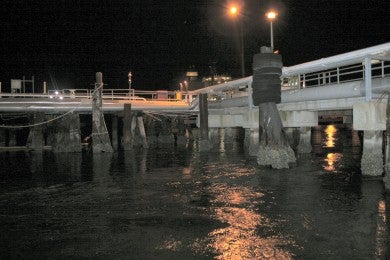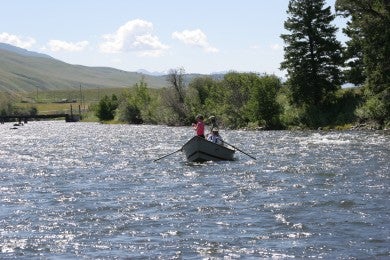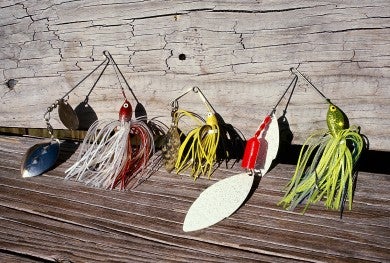Tips for Hot Weather Fishing Success
Bob McNally 07.06.15

Hot Night Fishing:
Night fishing is a traditional summer activity for thousands of anglers in many regions of the country. But often the most important part to good night success is selecting the right lake or river for your fishing.
Frequently, clear, deep lakes that have a lot of daytime use are prime night waters. Such lakes have water-skiers, sailboaters, speed boats, jet skis, and swimmers during the day. But at night, the bulk of human traffic goes home, and sportfish go on the prowl.
Look for bass, stripers, walleyes, crappies, bluegills, catfish and other species in typically good “feeding” areas you’d expect to locate them during a “hot bite” in the day. Points, islands, riprap, dam areas, weed lines, docks and pilings all can offer excellent night fishing. Some of the best and easiest to fish night spots are where there are large lights that shine down into the water–like around docks, piers, marinas and some lake dams.
Lights attract insects, which draw minnows, and that pulls in feeding game fish. Sometimes bass, crappies, catfish, and others can be caught right in the bright parts of lights shining down into the water. But often the biggest, oldest, and most shy sportfish hold in the dark, just outside a light beam hitting the water’s surface.
Fish slow and methodical at night. Fish at night can have a difficult time homing-in and hitting a lure, so make it easy for them. Slow-swimming minnow-like lures, chugger plugs, buzz-baits, and big spinner-baits with large Colorado blades are good because they make a lot of commotion and put out a lot of fish-attracting vibrations.
Rapids Hold Hot Fish:
During the hottest, brightest parts of summer, many fish (and plenty of surprisingly big ones) can be found holding in riffled stream or river water. This even occurs on some waters where there are deep holes and under-cut banks offering fish plenty of shade.
There are several reasons fish “hold” in riffles. One, such water is highly oxygenated, and since low-oxygen levels stress fish in some rivers, they naturally gravitate to riffled water. Further, in riffles and rapids minnows, crayfish and stream nymphs are tumbled around in the water column and disoriented, which makes such places excellent feeding sites. Riffles also often “funnel” river water through narrows, which makes them natural places for game fish to ambush prey.
Any mid-stream current break in a riffle could be a key holding spot for fish to ambush prey. Casts should be made above, to the side, and below such stream breaks, which can include boulders, log jams, and bridge pilings.
Fish commonly found in summer riffles include most trout, smallmouth bass, some sunfish, and in deeper, slower riffles catfish and largemouth bass are available.
Many live baits score well in riffles, but artificials do, too. Soft plastic jerk baits, spinners, spoons, small crankbaits, and streamer flies and nymphs can be counted on to catch most riffled-water species.
High-Speed Lure Retrieves:
While there are no “absolutes” in fishing, during summer when the water is warm and cold-blooded fish are more active, high-speed lures often catch fish that ignore lures that inch along bottom.
This is just the opposite of what many anglers believe. The old wives tale about the “dog days of summer” still persists in many fishing regions. Such anglers believe that a slowly worked plastic worm, jig, or spoon is the only way to catch “lethargic” summer fish.
While slow lure speeds may at times work in summer, faster lure speeds more frequently are the norm.
Naturally, faster cranking techniques with plugs, spoons, spinners, and plastic worms likely will produce more summer fish. But more subtle ways of increasing lure speed can be accomplished and may tempt more fish into striking. For example, use a heavy spinner-bait with a smaller willow leaf blade that spins fast as the lure “drops” more quickly than a light spinner-bait with large Colorado blades. Such a lure has a lot of flash and sparkle due to its fast-spinning blades, and that draws active, summer fish.
Often a crankbait with a tighter, “shorter” wobble will catch more fish in summer than a similar lure with a slower, wider arch in its wobbling action. A curly-tail worm looks like it’s moving faster than one with a normal or straight tail. Curly-tail worms added to spoons and spinner-baits can make them appear as though they’re moving much faster than they really are.
“Bump” for Bass and Others:
For some reason, a lure that “bumps” or slams into an object or the lake or river bottom during a retrieve often is struck by fish that ignore the same lure that doesn’t “bump” cover. This is especially so in summer, when bass, pike, trout, walleyes, muskies, and other fish are particularly active.
“Bumping” is easy to do and doesn’t take much altering of lures or retrieving techniques. Just make sure that when you’re casting a spinner-bait to a lily pad or bulrush clump, you pull the lure right into the cover, allowing it to “bump” and carom off. Be sure crankbaits are brought in so they bounce off a bridge abutment or dig and hop along bottom, a rock retaining wall, standing timber, brush, or riprap bank.


